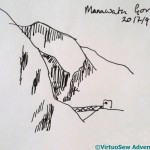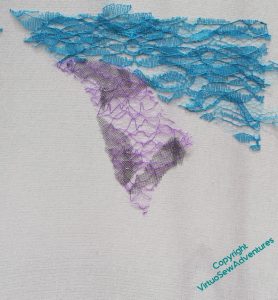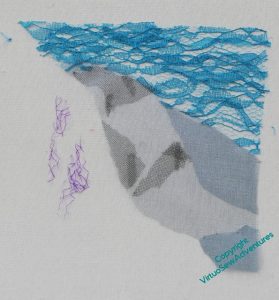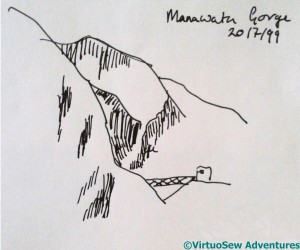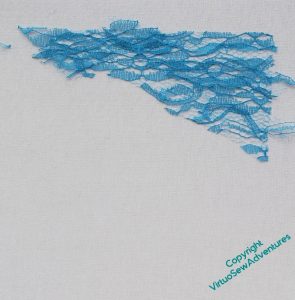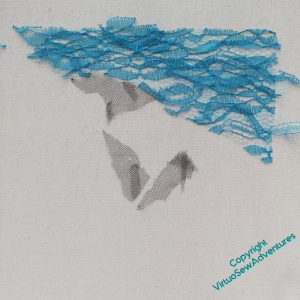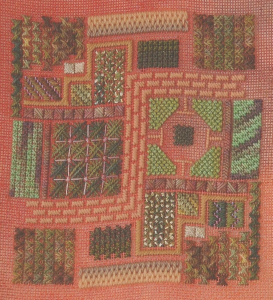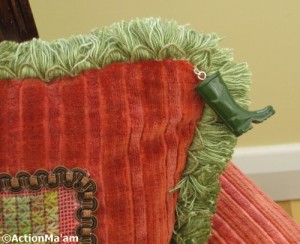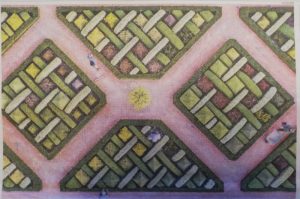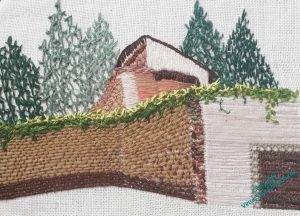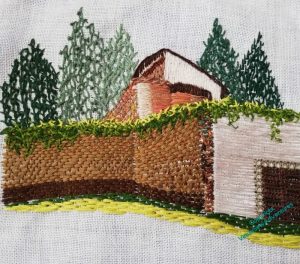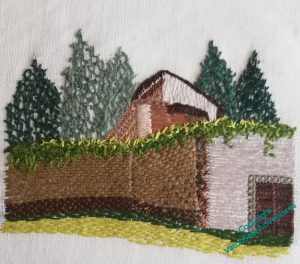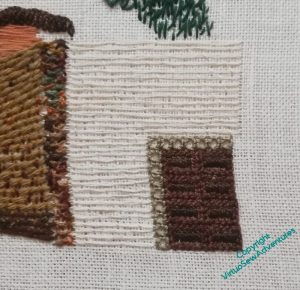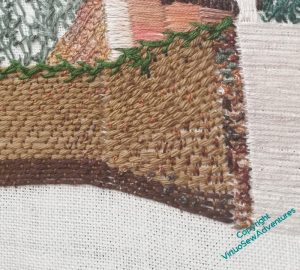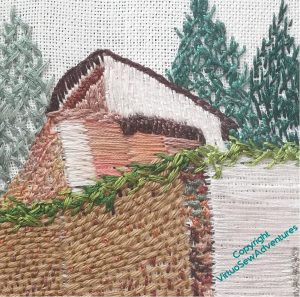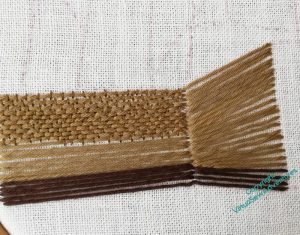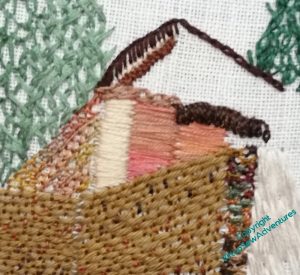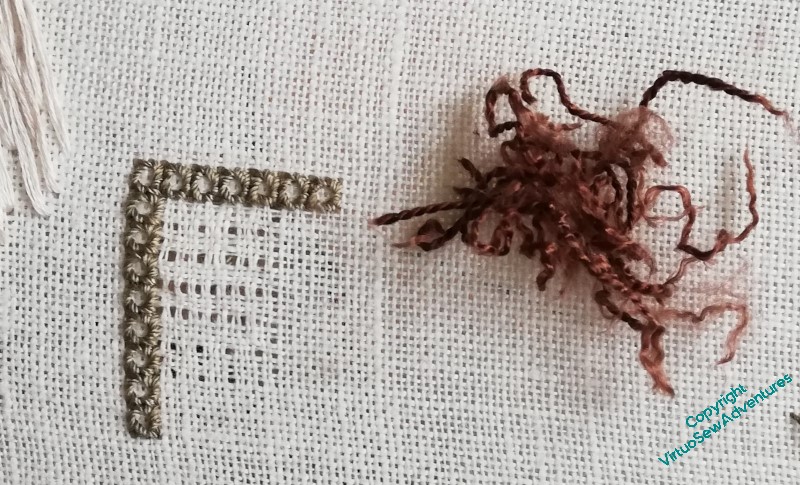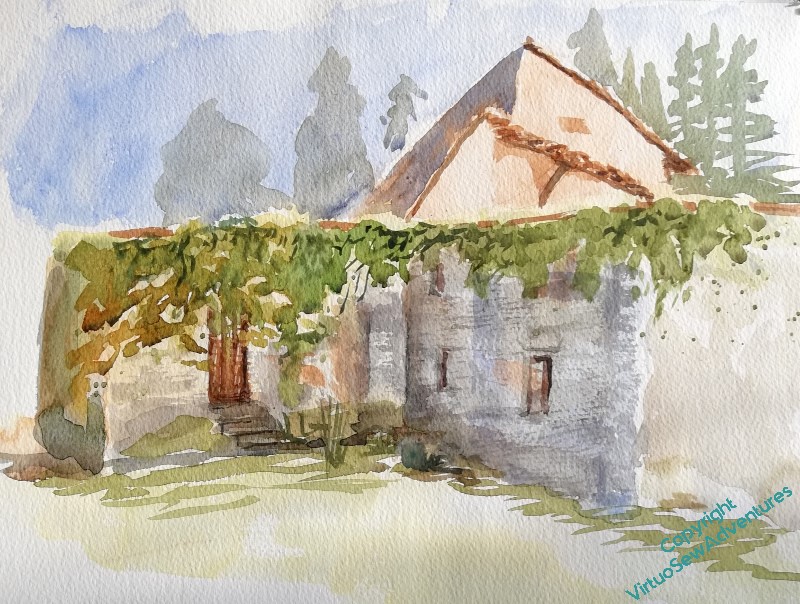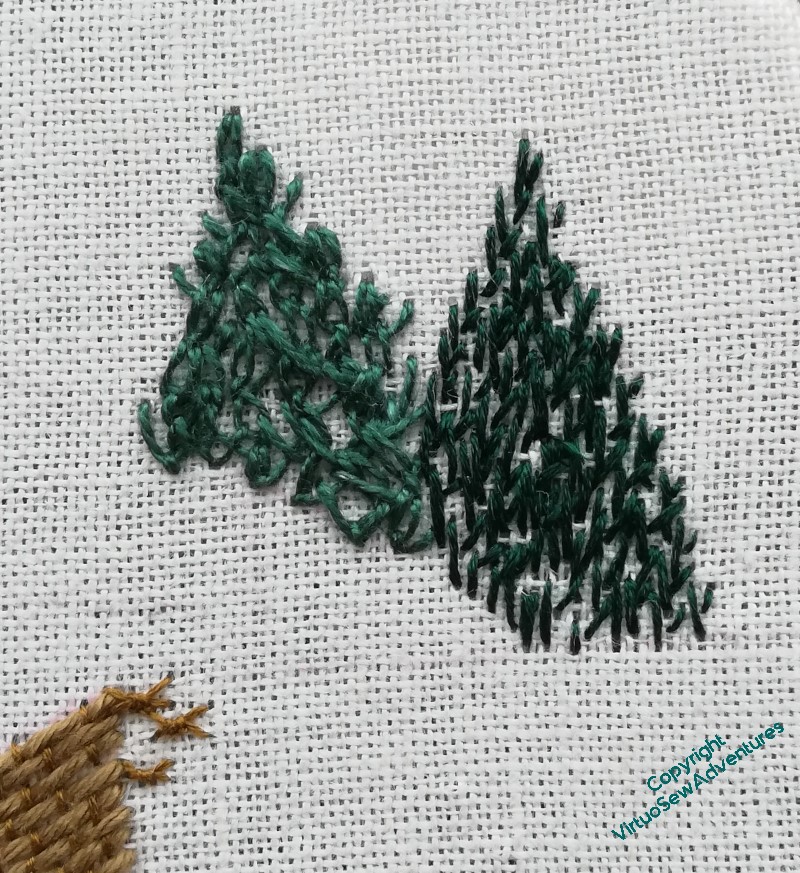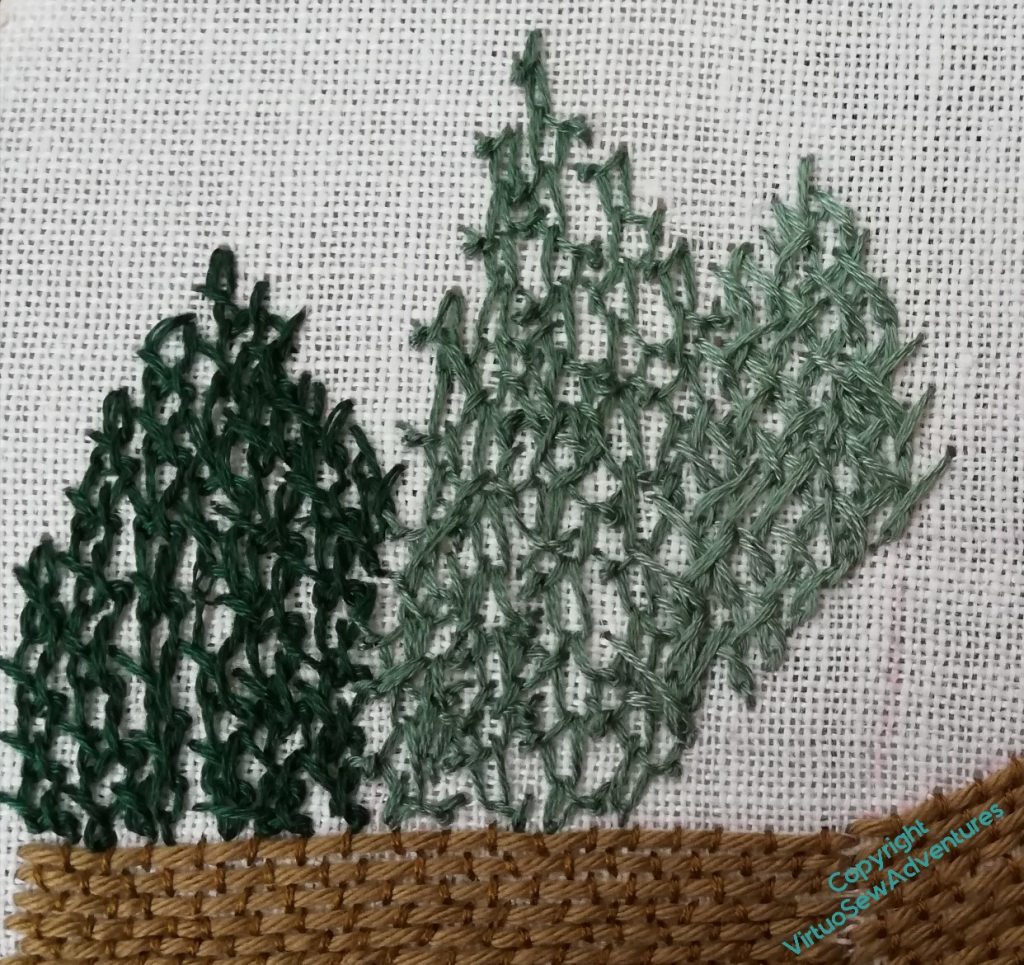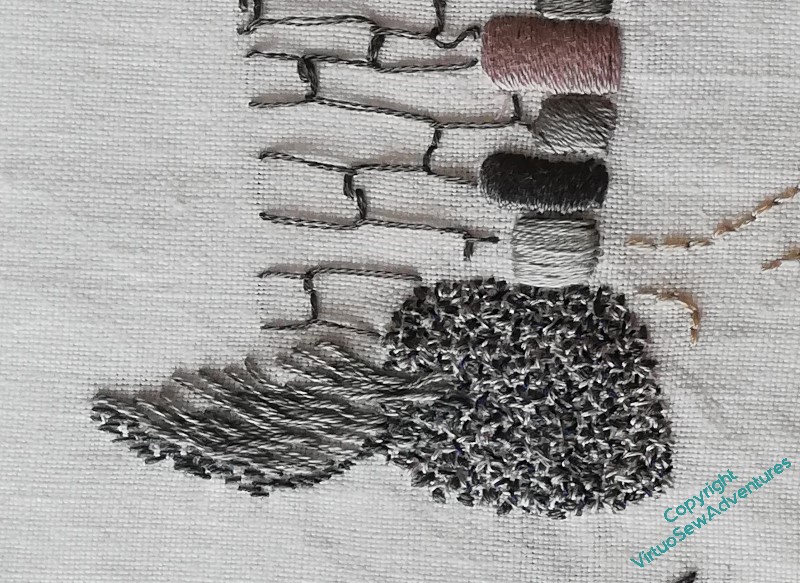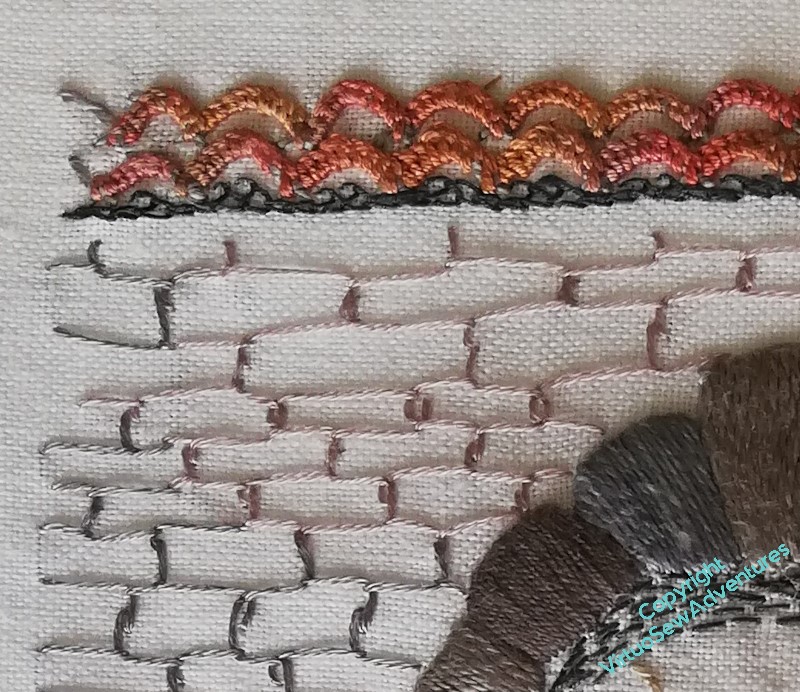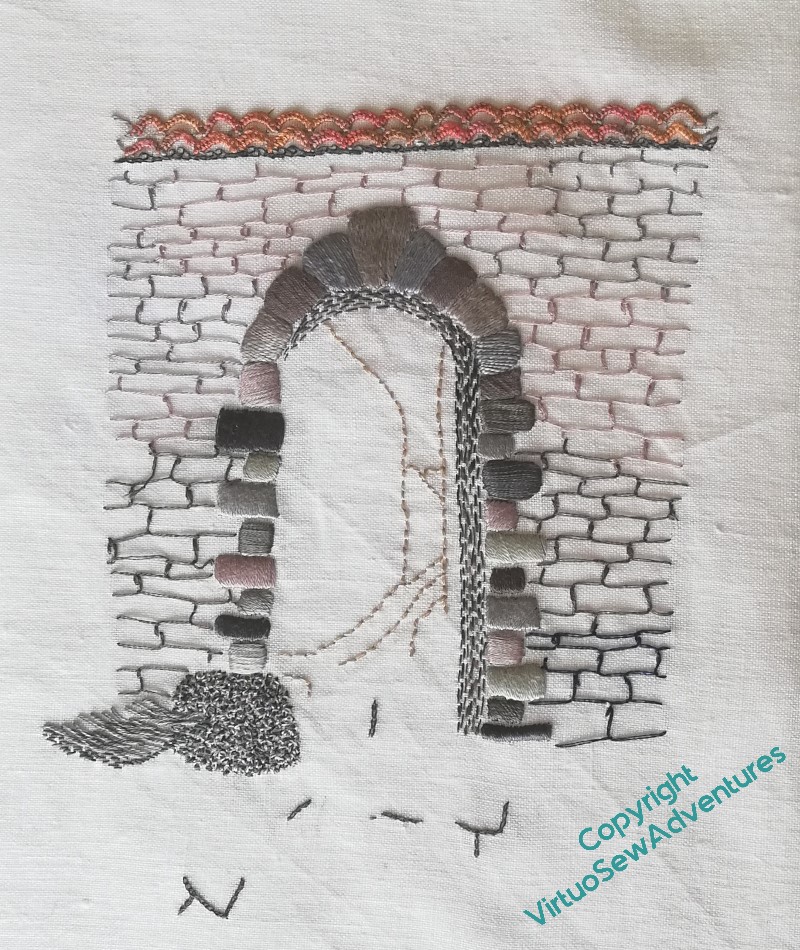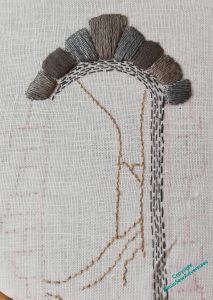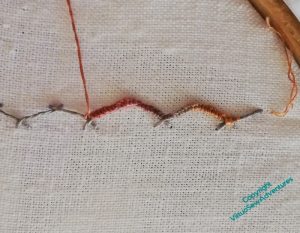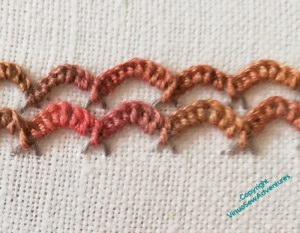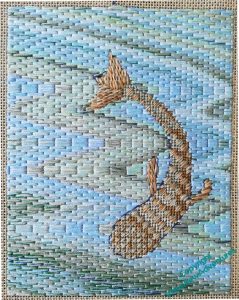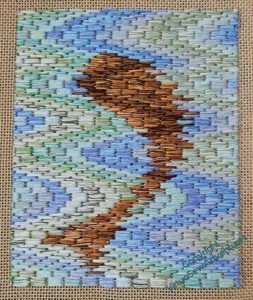Tag: experiments
Continuing to experiment with Manawatu Gorge..
One should always try to think a project through at least a little bit. I didn’t. I thought that once I got started this would be easier than it turned out to be.
The black net was fairly easy to cut and catch down, and I wanted that to stand in for the shaded areas on the sketch, but the purple net was an unrelieved menace – it caught on the threads I used, and tied itself in knots, and even failed to have a bit of itself under some of the stitches I made, so it didn’t stay in place. All in all, rather exasperating, and even worse when I decided that it wasn’t, in fact, doing what I wanted it to do, and had to remove it again!
I’m still meditating on the possibility of a canvaswork version of this, possibly made even more abstract, but I still want to finish this one some way, so, onward!
I had another look at the sketch and realised that the engine house for the bridge needed something to stand on – that explains that extra bit of gauze in the bottom right-hand corner. Then I decided that I would roll back from the complicated bits of layering I’d been planning, and simply try to create recession with tone. So far, I think it is working…
Manawatu Gorge Experiments
As you see, this sketch is from a long time ago. It was probably done in about ten minutes, in a pause on the road out of Palmerston North.
I found it a little while ago, and thought it would be interesting to see whether I could produce something pleasing in stitched form, using this as the basis. In particular, since it’s so long ago, and I couldn’t for the life of me find any other source material, this is all I have.
My first idea was to play with layered laces and gauzes, purples and blues because we were there in winter, and there was a lot of snow, bright blue skies and wonderful coloured shadows. There were some limitations in the laces and gauzes I could get hold of, so some of the adventure will be in making this work!
I haven’t drawn anything on the fabric, and I am cutting my laces and gauzes more or less freehand against the sketch. Compared with the painstaking stitching on William Marshall, the pieces are almost tacked into place, and there isn’t at all the same sense of quiet productivity.
I’m also contemplating a canvaswork, and more abstract, version of Manawatu Gorge, but just while I was writing this post, I came up with an idea for another layered gauze version. So I have more experiments to make!
In other news, Episode 76 of Slow TV Stitchery is now live: In which the Hunting Cat piece is mounted, and we discuss feature creep, tapestries as woven wallpaper with acoustic properties, and the depiction of layers of recollection.
Another new project to think about
Remember this? It was an exploration of canvaswork, a very long time ago, and when I’d finished it, I hadn’t the vaguest idea what to do with it. Then my cousin said she knew exactly what to do with it, and could she have it, please?
She and her local soft furnishing people turned it into a rather fabulous cushion, and it has been sitting happily kicking welly-booted heels in the air on a chair in her conservatory ever since.
Fast forward to some recent reorganising in her house, and she has a another chair that might be interested in a companion piece. Not the same shape, and not the same canvas, fortunately, and not necessarily the same colours either, just similar. I have to find the canvas before I can get excited about this one, so it will be a while, but I do have something to think about.
My cousin found a gorgeous drone shot of a knot garden in a National Trust property, and said “Start from this!”. The central tree might even end up as a sculpted piece of one of the pile stitches – that would be fun, wouldn’t it!
I’m thinking I might choose to use a brown canvas this time, and use as many variegated greens as I can lay my hands on. But as I’m not sure where I’ll find the canvas, my ideas have plenty of time in which to change….
Watermill Stitchery – Convento del Carmine
Once the walls were in place, I worked on the creepers.
As you can see here, this involved not just more of the same, but a few extra tendrils, and some mixing of the number of strands and stitches used to create the right tangled effect. Feather stitch, floral feather stitch, feathered chain stitch, all layered up in a variety of shades, to increase the tangle almost to “Sleeping Beauty” proportions.
Yes, good so far.
Then I decided that it really needed the grass at the front to pull the golden green forward, as it was in my memory.
Not like this, however. I think the choice of irregular running stitch is right, but although I chose to use six strands for the lighter colour to help pull it forward and push the building back – which is a good, rational, thought-through reason – it hasn’t worked as I envisaged. Cue some muttering and unpicking!
But I got there in the end…
In fact I’m very pleased with how this turned out. It allows me to demonstrate how to create different textural effects, even with a fairly restricted choice of thread – nothing exotic here, pearl cotton, soft cotton and stranded cotton.
I could add more details – roughen the stone further, add windows and doors to the walls in the shade – but I don’t think that the picture would be materially enhanced. And almost the whole trick with representative embroidery is the same as it is with painting: the finished piece is a new creation, not a copy of the thing it represents, so it is more important to end with a pleasing piece than an accurate report.
Watermill Stitchery – more progress on the Convento
I finally had a couple of inspirations for the rendered wall and the door. I used two shades of brown pearl cotton for the panels on the door, outlining them using long legged cross stitch, and filling in the panels with satin stitch. While I was doing that, it occurred to me that this was a good opportunity to demonstrate, again, just how different a stitch can look if you use different threads to stitch it with. So the render is rendered (sorry!) in Burden stitch, using two strands of light coloured stranded cotton, and already you can see how very different it looks in comparison with the soft cotton. It’s very satisfying when something works that well!
It was the golden light on the creeper that originally attracted me to this scene, so I need next to work out how to represent the creeper. I’m starting with feathered zig zag chain stitch, and I’ll use several colours of thread to create the variation of colour in the foliage.
I’ve added a few French Knots to the rough stone wall, to roughen it up a bit, and tweak the colour balance.
You can see here the start of the middle shade for the creeper, again using feathered zigzag chain stitch, and trying to zigzag the zigzags to vary how much of each colour shows.
You can also see that the facing light rendered wall is now done, and I have simply turned the Burden Stitch through ninety degrees. I think I may be beginning to be pleased with it!
Watermill Stitchery – continuing the Convento
Burden Stitch does a good job for the wall – you can see it starting here. I’ve used Soft Embroidery Cotton for the underlying straight stitch and a mixture of single strands of ordinary stranded cotton with one of the slightly heavier and more tightly twisted threads from Caron Collection, which has a whole series of warm red and brown colours with some greenish ones to help suggest the variation of colour in the stone wall. I’ve used darker soft cotton at the base of the wall, where there will be deep shadows on the lawn to “ground” the building.
The buildings showing above the top of the creeper-bedecked wall are all rendered rather than rough stone, and I had a bit of fun trying to pull together stitches and threads to represent the tiled roof, shadows under the eaves, the render and the woodwork. How pleased I am with how this section work changes day by day, so I shall leave well alone, until I’m either Definitely Dissatisfied or Supremely Satisfied!
In the bottom right hand corner, you can see the first attempt I made to depict the render on the facing wall, and the rough-cast feel of the turn of the wall. I’m not happy with the roughly-done, diagonal encroaching satin stitch, but I’m very pleased with the multicoloured mixture of French Knots, diagonal cross stitch, and Danish Knotted Cross stitch.
While I was rethinking the render, I worked on the door, which again, was not without missteps. The door surround, I am happy with – it’s Squared Chevron Stitch (found in one of my Edith John books), worked as a counted stitch. I then tried alternating two versions of Herringbone Stitch, hated it, and unpicked it promptly.
Oh, well, second mouse gets the cheese!
Watermill Stitchery – Trees at the Convento del Carmine
Very wisely, Bill and Lois, who run The Watermill At Posara, organise a variety of places to visit and paint, and in particular, the peace and quiet of the Convento del Carmine came the day after Excursion Day, which has people everywhere!!
I painted this watercolour when I was there, and in fact it shows something other than what I remember when I don’t look at it. What I mostly remember is dark foliage setting off the building in front, so for the embroidered version, that is what I intend to emphasize..
Now, remember, each of my Watermill Stitcheries is a sampler of experiments and ideas. I may or may not like all of them, but they should give my students points to ponder and places to start.
With that in mind, each of the trees is going to be in a different stitch. In each case I have worked vertical rows of the stitch, overlapping and interlocking them as best as I can to evoke the texture of the leaves.
I started, on the left, with Feathered Zigzag Chain Stitch. I’m quite pleased with this – you entirely lose the pattern of the stitch, but it evokes the movement of leaves in a breeze rather successfully.
I can’t say the same of Kerman Stitch, on the right. The breeze has stopped here, even if the impression of texture remains!
Working inward from the left, the first of these is Rabbit Eared Chain Stitch, found in Edith John’s “Creative Stitches”. This stitch is based on twisted chain stitches, which encouraged me to hope for a sense of movement again. I don’t think I quite hit the mark with it – maybe I never got quite comfortable enough with it – but I think it has possibilities.
The next one is Zigzag Crested Chain, again from Edith John. Crested chain is a stitch I enjoy but always find it moves under my needle. This time it ended up longer and thinner than I intended it to be – but maybe that was right for the purpose…
The final one is the slightly less peculiar Twisted Feather Stitch, and here, perhaps because it felt a little more familiar, more akin to the feathered zigzag chain I started with, I have my sense of movement and breeze back again.
I’ve begun the building in Burden Stitch, and now need to finish that, add more of the roof, and finally the creeper falling over the top of the wall. So watch this space!
Watermill Stitchery – Finishing Stones of Verrucola
You may recall that I was planning to use this design as a way to explore stonework in various forms, and to demonstrate stitches that might be chosen in each case.
So here we have padded satin stitch for the cut and dressed stone of the arch, and seed stitch for the boulder beside it. The seat and the blocks of the wall around the arch are both in Cretan Stitch, the one spaced out and turned into a filling stitch of sorts, and the other compressed and set at a slight angle to represent the slightly dished stone seat.
This view shows the height of the padding on the keystone and the line of dark stitching under the tiles, which is a line of chain stitch feathered on one side only to get one crisp edge and one which suggests the darkness of the arch. You can also see from the shadows just how strongly raised the blanket stitched herringbone stitch appears.
The Cretan Stitch rows are carefully varied in length and depth to show how the rows of cut stone are not all the same height or length. This was a stitch much more easily worked in a hoop, where you can see the layout, than in the hand – even though I prefer working in the hand where I can.
And here is the finished “Stones of Verrucola”.
There are some elements which work much better than others. The outlines through the arch and the chain stitch edges of the flagstones may not be necessary, and the shadow under the seat is a little too small.
The seed stitches could have been bigger, maybe even grouped, and maybe emphasizing one of the lighter colours more, but I am very happy that all of the different textures are truly differentiated.
Besides, all that I am seeking to do is to demonstrate ideas that the students can take on or not as they choose. If at the end of the week I have a classful of mini-mes, I will have failed. What I want is a group who’ve tried, experimented, and each of them produced, maybe even only a fragment, but still something that makes me think, “Goodness, I wish I’d thought of that!”
Watermill Stitchery – Stones of Verrucola
I’m continuing to explore ideas for the course at The Watermill in Posara, and this one is inspired by the first outing of the painting course I went on. Verrucola is a medieval village and fortress not far from Fivizzano, with a deep stream valley, some very impressive buildings – and a delightful trattoria just inside the walls.
I want to explore the different ways an embroiderer might choose to explore the textures of stone that a site like this afford – the living rock of the hillside, cut stone used for building, and the shaped and smoothed stone used for architectural features.
You can see in the first picture that I have just “drawn in” the street beyond the gate with back stitch and used darning stitch to suggest the shadow beneath the arch.
I’m using padded satin stitch for the cut and smoothed stone of the arch, but since I find that an exasperating stitch, I’ve alternated working on the arch with the tiles which cap the wall which is pierced by the arch.
I found buttonholed herringbone stitch in one of Sharon Boggan’s books, but as you can see, my first attempt didn’t really produce the effect of the curved roof tiles that are so much part of the scenery in Tuscany. The linen herringbone stitch is too stretched out, and the two strands of stranded cotton just look straggly.
I am going to have to emphasise experimentation in the course, aren’t I!
This version is much better – the shorter, higher herringbone stitch, just peering through at the base of the arches, three or even four strands of stranded cotton for the buttonhole stitch, and the stacked stitches create a good recollection of the tiled roofs I saw. I’m pleased with the way the variegation suggests the weathering on the tiles.
You will see that I have added a Page to the site which will make it easier to find and download details of the course if you are interested.
And also, Episode 71 of SlowTV Stitchery is now live, in which I experiment with the shore, and talk of plans for overland travel for Times To Come..
Fishy Lessons
So now, having finished my two fishie experiments (there may have been a third in the pipeline, but I’ve forgotten what it was!), what can I say I’ve learnt?
First, canvaswork stitches against the freeform bargello. There’s a sort of stillness, almost a static quality to this fish, in spite of the flowing bargello.
The bargello works well, although now I look at it, I’ve not managed to keep it flowing from top to bottom. And it was remarkably difficult to keep track of the pattern across the fish.
The second fish was an attempt to suggest the broken outline of an object seen through the interface between air and water. So this time, the pattern of the bargello ran through the fish, and I had to decide at each edge whether to stitch in the fish colour or the water colour. The pattern runs more successfully from top to bottom of the piece, but the whole thing looks a lot more active, maybe too active.
I think the colours are a bit too bright and swimming pool-like, but as these are experiments, using stash, I’m not too concerned about that. What does concern me is that even after these two, fairly substantial pieces, the appearance of a particular blend of threads as it was stitched was sometimes a surprise. It will be hard to pick the right colours to use if I can’t rely on my imagination of how the thread will stitch up.
So, I don’t know whether I will use this idea for the borders of Placidus, but I’ve got plenty to think about, haven’t I!
Episode 69 of Slow TV Stitchery is now live, on talking projects, the development of musical taste, and the challenges of suggesting wind over the water.

